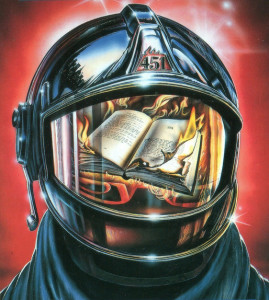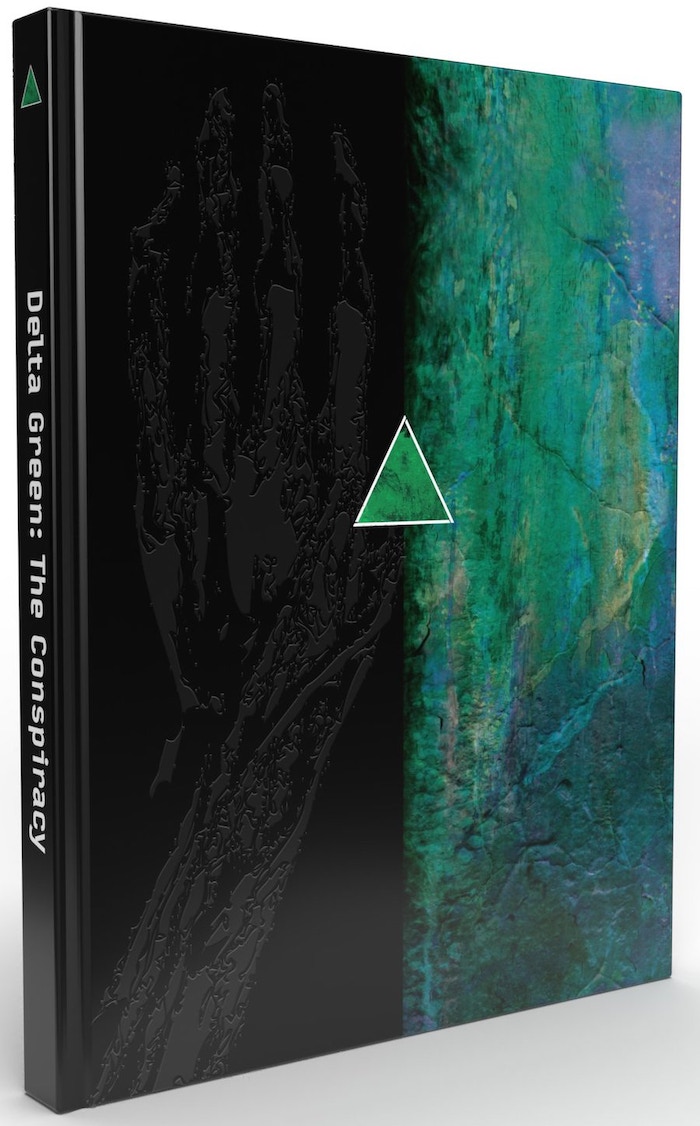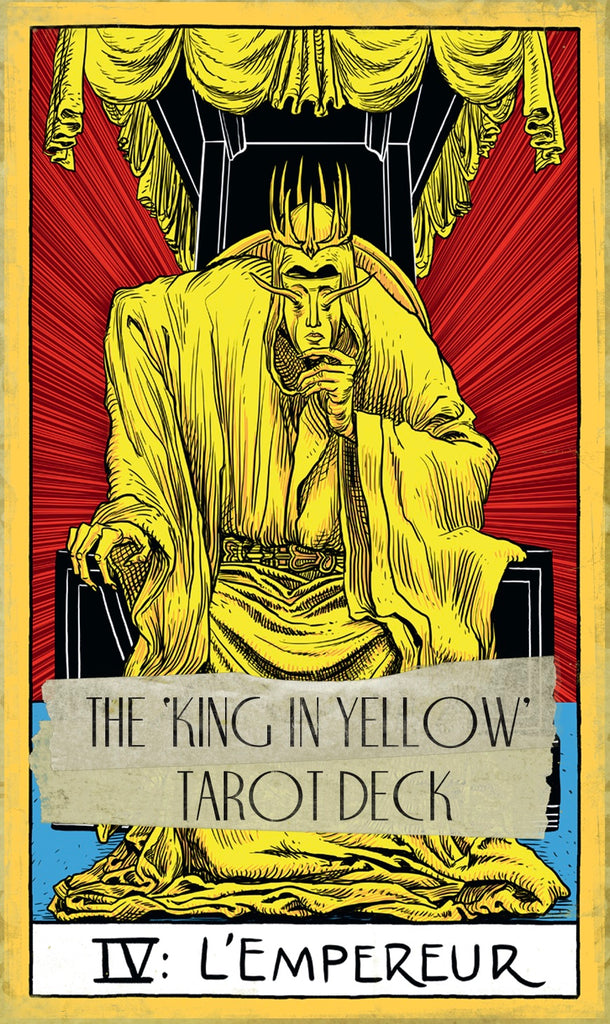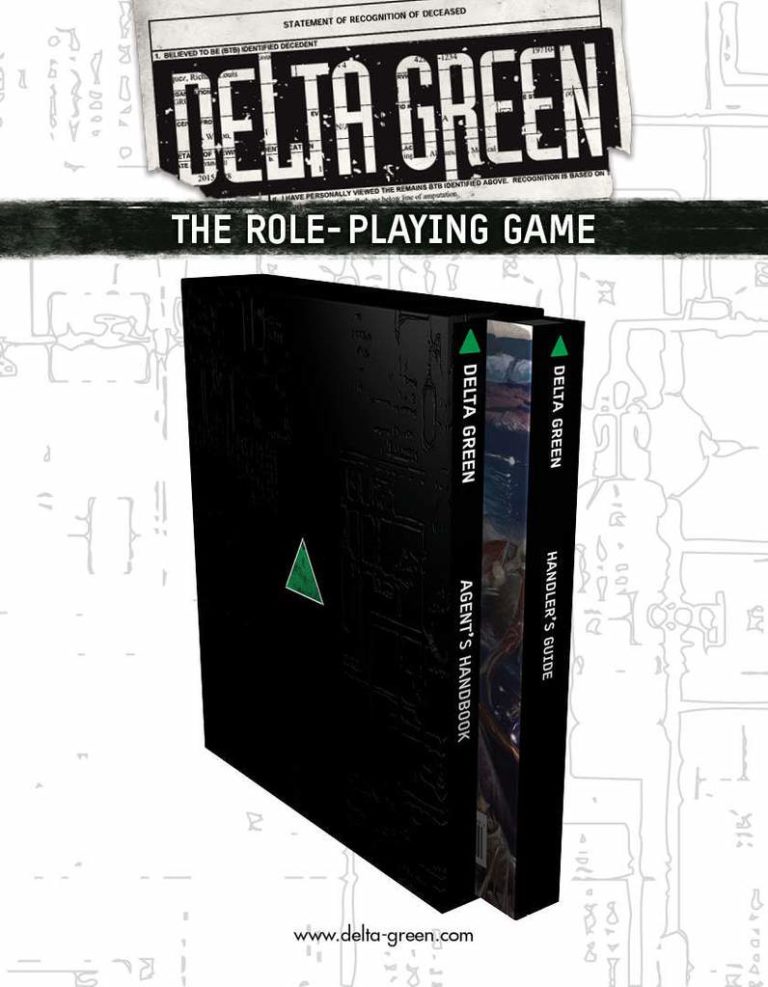By Adam Scott Glancy, © 2012
Writing this Directive I’m taking a break from the Delta Green post-9/11 update, our new Delta Green book that will cover the changes to the fictional Delta Green universe caused by such real-world events as the 9/11 attacks and the War on Terror, Hurricane Katrina, the Indonesian tsunami, the Japanese earthquake, and political upheavals like the ongoing Arab Spring. Perhaps Osama Bin Ladin’s assassination will be the end point of this update? But fear not, gentle readers. We’re bringing Delta Green into the 21st century.
Fahrenheit 451 cover art by Steve Crisp
While working on the new material one issue has been foremost in my mind: the official canon. Understanding what comprises canon is supposed to prevent contradictions and inconsistencies when new material is published. But of course, you can’t have contradictions unless you start treating certain material as canon. So the desire to have consistency is exactly the sort of thing that breeds contradictions. How’s that for a paradox?
The issue of official canon is different for a role-playing game universe than it is for any other kind of vast narrative, be it a series of books, a comic book title, a long-running TV series or movie franchise. When those fictional universes are published, broadcast, or released in theaters, they are complete. Role-playing games are not complete when they are published. Every publish role-playing game is a work of collaborative fiction between the authors, the players and the referee. The story doesn’t really exist until the players and referee execute it around their game table. So who’s to say what’s official canon? After all, every gaming group has a unique experience with the published materials.
That’s especially the case with the Call of Cthulhu role-playing game. It is a role-playing game based on an existing vast narrative, the Cthulhu Mythos, a fictional universe begun by H.P. Lovecraft but added to over nearly a century by scores of authors. H.P. Lovecraft himself encouraged his fans and friends to borrow his material right from the beginning, just as he borrowed theirs. From the moment it was conceived, the Call of Cthulhu role-playing game inherited that status as both a massive narrative and a shared universe.
The muddled nature of the literary Cthulhu Mythos makes the question of what is canon for Call of Cthulhu even muddier. Lovecraft scholars like S.T. Joshi consider everything written for the role-playing game system to be non-canonical, right down to the commonly accepted names of Lovecraftian critters that, although developed for the game, are now used in the derivative fiction. Names such as byahkee and dimensional shambler don’t appear in Lovecraft’s work even though the creatures themselves were well-described. They weren’t named until Sandy Petersen and Lynn Willis came along.
When John Tynes, Dennis Detwiller and I began work on Delta Green we considered it to be an alternate/non-canonical sourcebook for Call of Cthulhu that did not have to necessarily agree with all previously publish Call of Cthulhu materials. Maybe it was the influence of Vampire: The Masquerade, but I did not want to get painted into a corner by official canon, or make my fictional universe so cluttered with canonical events that they players had no room to maneuver to create their own adventures. The return of the Great Old Ones always needed to be a looming threat, but it need to stay just over the horizon.
Even then we were hesitant to advance the Delta Green universe’s timeline or publish materials that would establish set outcomes for situations that appeared in previous sourcebooks. The reason for this was that we didn’t want to script outcomes to conflicts in the Delta Green universe that the players should be creating for themselves. That’s one of the reasons the novels and short stories set in the Delta Green universe are not considered canon for the role-playing game. They’re just our take on how things could turn out. How it turns out for your players is a whole different matter.
Elements of Surprise
Because role-playing is collaborative, there is no guarantee that what the author wrote is going to cover more than a few of the eventualities the players will generate through their choices. That means that the Keeper will likely need to b prepared to improvise new NPCs, locations and narratives to fill in the gaps in the published material. Very little published material can be run exactly as written. As a Call of Cthulhu author, you hope that Keepers will use the material you prepared, but you accept that no game or scenarios is going to survive contact with the players. When it comes to official rules and game universe canon, players and Keepers are more concerned with “getting it right” than the authors and publishers.
Some fans have complained that there just isn’t enough Delta Green material on the market. It always seemed to me that if a Keeper tried to throw every antagonist we’ve every written into a campaign, things would get pretty cluttered up pretty damn fast. The Keeper simply can’t use everything at the same time. Instead the Keeper is going to have to create his own canon for his own players, picking the options that are going to be the most fun for their group.
So, really, nothing is canon, at least not until the Keeper presents it. Once the Investigators learn a fact about the Delta Green universe, then it’s canon.
If Majestic-12 is too X-Files, or the Karotechia is overly “pulp,” or Stephen Alziz is way too deus ex machina, then I see no reason why a Keeper has to use them. A Keeper could just as easily drop Delta Green itself and run a campaign base on SaucerWatch, Phenomen-X or PISCES.
Frankly, I wouldn’t necessarily stop with editing the elements that are specific to the world of Delta Green. I would go after the Cthulhu Mythos as well. One of the biggest hurdles in writing (or running) Call of Cthulhu material is that many gamers have been playing this classic for as long as it’s been on the market. It is quite a trick to surprise players who’ve been playing and reading Mythos material for years or decades. With Delta Green we’ve presented old Mythos threats in new guises and on new stages, beginning by wrapping the old horrors of the Mythos inside modern conspiracy theories. But as players become more familiar with the Delta Green campaign setting, even these changes in set and costume are not going to surprise players. Even if a Keeper is lucky enough to have players who don’t metagame and react to the mystery based on player knowledge rather than character knowledge, it’s always better to find ways of delivering mystery and horror in ways that aren’t simply the tally of the Investigators’ Sanity points or skill rolls. Genuinely surprising the Investigators is every Keeper’s holy grail.
There are three tactics I can recommend to surprise your players. All of them involve knowing when to stop worrying about the canon:
Drop the Mythos
The first tactic is to steer clear of the Cthulhu Mythos. John H. Crowe, a longtime Pagan Publishing author, has definitely adopted this tactic. He spends his time combing through books on folklore in search of critters that he can inflict on his playtesters. Pagan Publishing’s upcoming book, Bumps in the Night, is a collection of just those kinds of scenarios. Using the BRP rules, John Crowe has crafted scenarios around supernatural threats that the players won’t find in the core rulebook or in Malleus Monstrorum. I won’t give anything away here about Bumps in the Night, but he’s inflicted upon me such horrors as non-corporeal Irish vampires, Mesopotamian rape monsters and Norse barrow zombies. None of these horrors have any connection to the Cthulhu Mythos and every one of them ruined my Investigator’s day.
The only problem with this approach is that it depends on the individual Keeper’s campaign canon. If the Keeper has already established that the only genuine supernatural forces are those of the Cthulhu Mythos, then bringing in non-Mythos folklore may not sit well. Revealing a Mythos creature or Outer God as the truth behind some folklore or myth is one thing, but bringing in other mythologies as existing wholly and separately from the Cthulhu Mythos is another.
Add to the Mythos
The second tactic is to make new Cthulhu Mythos material that fits the goals of your campaign. Writing new material for the Cthulhu Mythos dates back to Lovecraft encouraging fans and friends to write material based on his stories. The Call of Cthulhu RPG has certainly added plenty of new material over the decades, from the Goddess of the Black Fan to the insect colonies of the future Great Race of Yith. Creatures from horror literature have also been statted up for Call of Cthulhu, everything from Triffids to the Thing from Another World. As long as the Keeper makes sure to anchor these new additions to the Cthulhu Mythos then there will be fewer complaints about the violation of canon. But a big piles of eyes, tentacles and mouths does not a Great Old One make. Lovecraftian horrors should be more than just some unpronounceable creature to which debased cultists or deranged sorcerers throw the occasional sacrifice. They need to touch on the themes of Lovecraftian cosmic horror; Man’s insignificance in the universe; the threat of science revealing too much; the price men will pay for knowledge and immortality.
Change the Game
The last way to surprise players is by changing the game. This can be anything from using a different set of game mechanics to changing the game stats. These days BRP isn’t the only way you can inflict the horrors of the Mythos on your players. The Gumshoe system has Trail of Cthulhu. Savage Worlds has Realms of Cthulhu. You can ambush your Thrilling Tales players who think they are playing in a two-fisted, villain-punching Pulp-style game with horrors from the Cthulhu Mythos. My first exposure to the Cthulhu Mythos didn’t come playing Call of Cthulhu. It was GDW’s science fiction classic Traveller. Suffice to say, having never run into Cthulhu cultists before that moment, I was knocked out of my socks during the big reveal.
Fiddling with the games stats can be a sure-fire way to surprise your players, especially if it’s a critter they are familiar with from reading the rules. It’s also a sure-fire way to annoy them, especially if their Investigators have already encountered the monster before. Adding new powers or taking away old ones may come off as capricious. Personally I think that if the problem with a scenario is that the monsters isn’t tough enough then the Keeper should get a different monster, find a way to separate the Investigators from their firepower, or run the monster a little smarter so that it isn’t just wading into the Investigators to get mowed down. I favor giving the smarter monsters spells to enhance their lethality. As bad as it is taking on a dimensional shambler, one armed with a couple of spells is just awful.
The Keeper should always be willing to create new spells and modify old spells to keep Investigators guessing. Magic in Call of Cthulhu is something that is always evolving, not trapped in amber. The races that can create tools should always have the option of rolling out new gizmos and scientific atrocities to bedevil the Investigators.
The bottom line is that while canon in Delta Green is important, it really only affects the initial setup, the starting points of the campaign’s universe. After that, the story is in the hands of the Keeper and the Investigators. No Keeper should hesitate to heave the canon overboard if it’s going to cause his game to flounder.
Adam Scott Glancy






